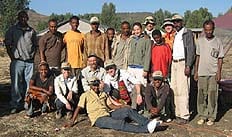 A team of researchers led by paleobotanist Bonnie Jacobs and sedimentologist Neil Tabor of Southern Methodist University returned to northwestern Ethiopia in late December 2007 to spend almost a month collecting additional plant fossils and gaining a more thorough understanding of their geological context.
A team of researchers led by paleobotanist Bonnie Jacobs and sedimentologist Neil Tabor of Southern Methodist University returned to northwestern Ethiopia in late December 2007 to spend almost a month collecting additional plant fossils and gaining a more thorough understanding of their geological context.
In December 2006, the team collected more than 600 plant fossils, which are on loan for study in labs at SMU’s Roy M. Huffington Department of Earth Sciences in Dedman College. All told, the team has documented more than 1,500 plant fossils, hundreds of vertebrate fossils and numerous examples of ancient soils. This year they widen their search to better understand the geology, landscape, plant and animal communities, and climate of Chilga, Ethiopia, 28 million years ago.
The project, which also is training Ethiopian students in geology and paleontology, is funded by a $300,000, three-year grant from the National Science Foundation.
In this second year of the grant period, the team will collect from a fruit and seed deposit — to compare with that collected last year — sample leaves to provide information about insect plant-eaters, and explore for new fossil sites, according to Jacobs, associate professor, and Tabor, assistant professor, both in the Department of Earth Sciences.
The 2007-2008 Ethiopia crew
The project is expected to help scientists understand the world’s changing climate, by knowing about that of the past based upon plant fossils and ancient soils.
Documenting past climate at low latitudes, including in Africa, helps researchers understand global climate change. In addition, the early origins of Africa’s flora are largely a mystery. What we know comes primarily from hypotheses generated by the modern distributions of plants rather than from the fossil record.

Angiosperms, “flowering plants,” make up nearly all living plants in today’s tropical, subtropical and temperate regions. In Africa, little is known about how they changed and adapted between their evolutionary origins 130 million years ago and recent times. Chilga fossils provide a unique view of the Earth’s plant life 28 million years ago, and fill a gap in understanding the evolution of today’s tropical floras.
The 2006 effort focused on, CH-3, which was known to produce both plant and vertebrate fossils. Until last year, only 92 plant specimens had been collected from CH-3 and these all came from the surface. These are usually bigger, less delicate specimens because they’ve been exposed to erosion and perhaps moved from their original position in the sediment.
Bonnie Jacobs, Neil Tabor and crew
The researchers excavated into the hillside at CH-3, exposing the fossiliferous deposit and, after only eight days, collected 523 specimens — mainly fruits and seeds. Their finds included some things never seen before at Chilga, such as several flowers, some very tiny seeds, and a large fruit, all of which are still being studied.
Besides Jacobs and Tabor, the 2007 team included: SMU students Dan Danehy and Harvey Herr; John Kappelman, University of Texas at Austin; and Ellen Currano, Penn State University.
Related links:
Ethiopia project home page
Bonnie Jacobs
Bonnie Jacobs’ research
Neil Tabor
Dan Danehy
John Kappelman
Ellen Currano
Why fossils matter
Bonnie Jacobs’ guide to finding fossils
SMU Student Adventures blog: Research team in Ethiopia, 2007-2008
Roy M. Huffington Department of Earth Sciences
Dedman College of Humanities and Sciences
Mongabay.com: Climate shift in East Africa due to geology
 A team of researchers led by paleobotanist
A team of researchers led by paleobotanist